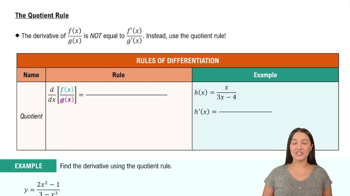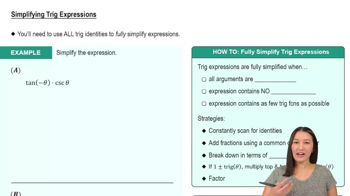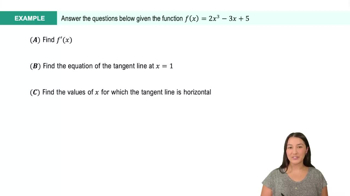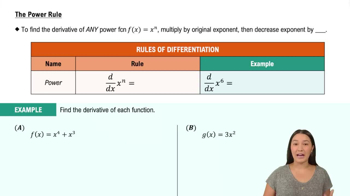Table of contents
- 0. Functions7h 52m
- Introduction to Functions16m
- Piecewise Functions10m
- Properties of Functions9m
- Common Functions1h 8m
- Transformations5m
- Combining Functions27m
- Exponent rules32m
- Exponential Functions28m
- Logarithmic Functions24m
- Properties of Logarithms34m
- Exponential & Logarithmic Equations35m
- Introduction to Trigonometric Functions38m
- Graphs of Trigonometric Functions44m
- Trigonometric Identities47m
- Inverse Trigonometric Functions48m
- 1. Limits and Continuity2h 2m
- 2. Intro to Derivatives1h 33m
- 3. Techniques of Differentiation3h 18m
- 4. Applications of Derivatives2h 38m
- 5. Graphical Applications of Derivatives6h 2m
- 6. Derivatives of Inverse, Exponential, & Logarithmic Functions2h 37m
- 7. Antiderivatives & Indefinite Integrals1h 26m
- 8. Definite Integrals4h 44m
- 9. Graphical Applications of Integrals2h 27m
- 10. Physics Applications of Integrals 2h 22m
3. Techniques of Differentiation
Basic Rules of Differentiation
Problem 3.50
Textbook Question
Derivatives of products and quotients Find the derivative of the following functions by first expanding or simplifying the expression. Simplify your answers.
y = 12s³-8s²+12s/4s
 Verified step by step guidance
Verified step by step guidance1
Step 1: Begin by simplifying the expression \( y = \frac{12s^3 - 8s^2 + 12s}{4s} \). This involves dividing each term in the numerator by the denominator \( 4s \).
Step 2: Simplify each term separately: \( \frac{12s^3}{4s} = 3s^2 \), \( \frac{-8s^2}{4s} = -2s \), and \( \frac{12s}{4s} = 3 \).
Step 3: Rewrite the simplified expression as \( y = 3s^2 - 2s + 3 \).
Step 4: Differentiate the simplified expression term by term. Use the power rule \( \frac{d}{ds}[s^n] = ns^{n-1} \) for each term.
Step 5: Apply the power rule: The derivative of \( 3s^2 \) is \( 6s \), the derivative of \( -2s \) is \( -2 \), and the derivative of \( 3 \) is \( 0 \). Combine these to find the derivative of the function.
 Verified video answer for a similar problem:
Verified video answer for a similar problem:This video solution was recommended by our tutors as helpful for the problem above
Video duration:
4mPlay a video:
Was this helpful?
Key Concepts
Here are the essential concepts you must grasp in order to answer the question correctly.
Derivatives
A derivative represents the rate of change of a function with respect to a variable. It is a fundamental concept in calculus that allows us to determine how a function behaves at any given point. The derivative can be computed using various rules, including the power rule, product rule, and quotient rule, depending on the form of the function.
Recommended video:

Derivatives
Product and Quotient Rules
The product rule and quotient rule are techniques used to differentiate functions that are products or quotients of two or more functions. The product rule states that the derivative of a product of two functions is the first function times the derivative of the second plus the second function times the derivative of the first. The quotient rule, on the other hand, provides a method for differentiating a quotient of two functions, ensuring that the denominator is squared in the final expression.
Recommended video:

The Quotient Rule
Simplification of Expressions
Simplifying expressions is a crucial step in calculus that often makes differentiation easier. This involves combining like terms, factoring, or reducing fractions to their simplest form. In the context of the given function, simplifying the expression before taking the derivative can lead to a more straightforward calculation and a clearer final result.
Recommended video:

Simplifying Trig Expressions

 3:59m
3:59mWatch next
Master Derivatives of Linear Functions with a bite sized video explanation from Callie
Start learningRelated Videos
Related Practice







